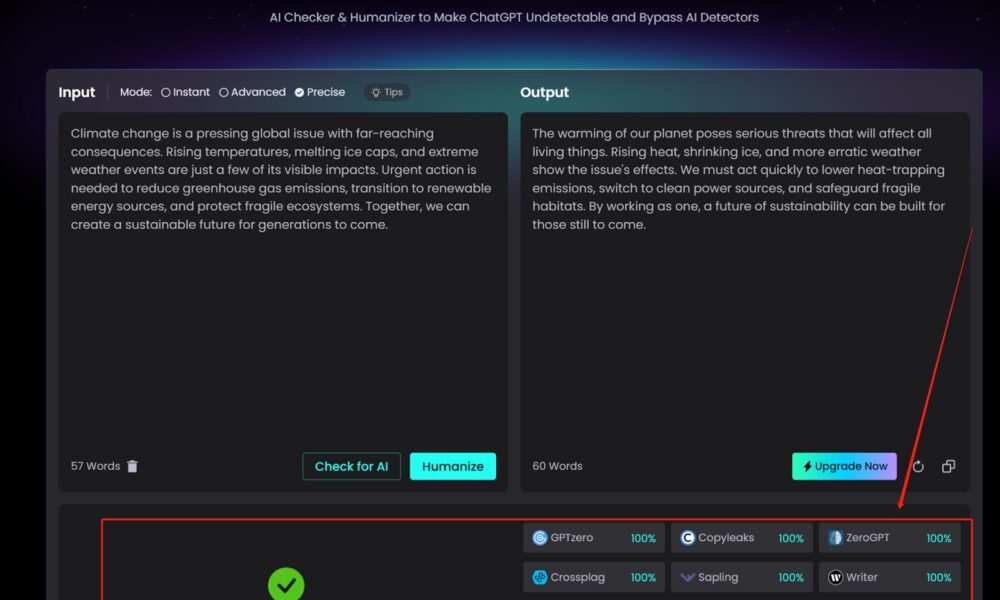In the rapidly evolving landscape of academic integrity and content creation, tools like Turnitin have become household names. Originally designed to combat plagiarism by comparing student-submitted texts against a massive database of existing works, Turnitin and similar platforms have adapted to the digital age by incorporating AI detection capabilities.
These enhancements are aimed at identifying content produced by AI-generated text tools, such as OpenAI’s ChatGPT, among others. However, this has led to a growing interest in methods to bypass Turnitin’s AI detection, not always for nefarious purposes but often as a means to ensure the seamless integration of AI in legitimate writing and content creation processes.
Introduction to Turnitin
What is Turnitin?
Turnitin is an internet-based plagiarism detection service used by academic institutions and publishers worldwide. Its primary function is to check the originality of written work by comparing it against an extensive database of academic papers, websites, and books. With the advent of AI, Turnitin has expanded its capabilities to detect text generated by AI writing tools, aiming to preserve academic integrity in the digital age.
Understanding Turnitin’s AI Detection
The modern iteration of Turnitin incorporates AI detection technology to identify submissions created by AI text generators. This technology is based on analyzing writing styles, sentence structures, and other linguistic patterns that may indicate non-human authorship. With a claimed accuracy of 98%, Turnitin’s AI detection has become a significant concern for students and content creators who utilize AI tools for assistance in content generation.
Why Bypass Turnitin AI Detection?
The motives behind bypassing Turnitin’s AI detection vary. For students, it might be to utilize AI tools as a form of assistance without facing penalties. Content creators may seek to streamline their workflows while ensuring their output is not flagged as AI-generated, avoiding potential issues such as false positives or undesired scrutiny. Importantly, bypassing AI detection should be done with ethical considerations in mind, ensuring the maintenance of academic integrity and originality.
Methods to Prevent Turnitin Flagging
Manual Edits and Enhancements
A straightforward approach involves manually reviewing and modifying AI-generated content to make it more “human-like.” This might include altering sentence structures, vocabulary, and injecting personal anecdotes or opinions.
Advanced Tools: Introducing Undetectable AI
Undetectable AI emerges as a specialized solution designed to address the challenge of bypassing AI detection tools like Turnitin. It functions by enhancing AI-generated text to resemble human writing more closely, thus evading detection mechanisms.
Features of Undetectable AI
Humanization of AI Text
Undetectable AI leverages advanced algorithms to adjust and improve the human-like quality of AI-generated texts. This includes refining sentence structure, word choice, and overall cohesiveness to mimic natural human writing patterns.
Bypassing AI Checkers
One of the standout features of Undetectable AI is its ability to bypass not just Turnitin’s AI detection but also other platforms such as ZeroGPT, Originality.AI, and more. It achieves this by intricately altering the text to eliminate identifiable AI writing signatures.
Content Originality and SEO Optimization
Besides making AI-written content undetectable, Undetectable AI ensures the output is original, plagiarism-free, and optimized for search engines. This is incredibly beneficial for digital content creators aiming to rank higher on Google without triggering AI detection algorithms.
Alternative Strategies to Undetectable AI
While Undetectable AI offers a comprehensive solution, several alternative strategies can also minimize the likelihood of AI detection by Turnitin:
- Manual Changes: Direct involvement in tweaking the AI-generated text to enhance its uniqueness and human touch.
- Prompt Optimization: Crafting AI prompts to generate more natural and informal text from the outset.
- Content Personalization: Incorporating real-world experiences, anecdotes, and personalized examples to enrich the text.
Ethical Considerations
Engaging in practices to bypass AI detection tools like Turnitin prompts a discussion on ethics. It’s crucial to balance the use of AI assistance with the commitment to originality and academic integrity. Tools like Undetectable AI should be used responsibly, ensuring that AI-assisted work adheres to ethical standards and guidelines set forth by academic institutions and content platforms.
Conclusion
The use of AI in content creation and academic writing is an undeniable reality of the digital age. As tools like Turnitin evolve to detect AI-generated text, solutions such as Undetectable AI offer a way to integrate AI into these processes seamlessly. When used ethically and judiciously, such tools can enhance productivity and creativity without compromising the authenticity and integrity of the written work. In the dynamic interplay between AI and content authenticity tools, the goal should always be to uphold originality and human ingenuity’.
